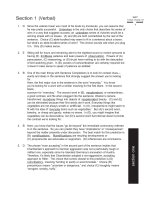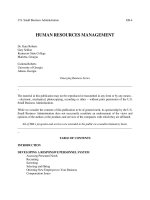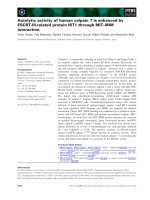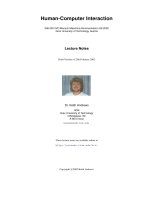VIRTUAL REALITY – HUMAN COMPUTER INTERACTION pptx
Bạn đang xem bản rút gọn của tài liệu. Xem và tải ngay bản đầy đủ của tài liệu tại đây (23.29 MB, 316 trang )
VIRTUAL
REALITY
HUMAN
COMPUTER
INTERACTION
EditedbyXin‐XingTang
VIRTUALREALITY–
HUMANCOMPUTER
INTERACTION
EditedbyXin‐XingTang
Virtual Reality – Human Computer Interaction
Edited by Xin-Xing Tang
Contributors
Giovanni Saggio, Manfredo Ferrari, Richard M. Levy, Stuart Gilson, Andrew Glennerster,
Ying Jin, ShouKun Wang, Naifu Jiang, Yaping Dai, Umar Asif, J.P. Thalen, M.C. van der Voort,
Alcínia Z. Sampaio, Joana Prata, Ana Rita Gomes, Daniel Rosário, Piovano Luca, Basso Valter,
Rocci Lorenzo, Pasquinelli Mauro, Bar Christian, Marello Manuela, Vizzi Carlo,
Lucenteforte Maurizio, Brunello Michela, Racca Filippo, Rabaioli Massimo, Menduni Eleonora,
Cencetti Michele, Yusuf Arayici, Paul Coates, Zhuowei Hu, Lai Wei, Wilma Waterlander,
Cliona Ni Mhurchu, Ingrid Steenhuis, Elham Andaroodi, Mohammad Reza Matini, Kinji Ono,
Kazunori Miyata
Published by InTech
Janeza Trdine 9, 51000 Rijeka, Croatia
Copyright © 2012 InTech
All chapters are Open Access distributed under the Creative Commons Attribution 3.0 license,
which allows users to download, copy and build upon published articles even for commercial
purposes, as long as the author and publisher are properly credited, which ensures maximum
dissemination and a wider impact of our publications. After this work has been published by
InTech, authors have the right to republish it, in whole or part, in any publication of which they
are the author, and to make other personal use of the work. Any republication, referencing or
personal use of the work must explicitly identify the original source.
Notice
Statements and opinions expressed in the chapters are these of the individual contributors and
not necessarily those of the editors or publisher. No responsibility is accepted for the accuracy
of information contained in the published chapters. The publisher assumes no responsibility for
any damage or injury to persons or property arising out of the use of any materials,
instructions, methods or ideas contained in the book.
Publishing Process Manager Mirna Cvijic
Typesetting InTech Prepress, Novi Sad
Cover InTech Design Team
First published August, 2012
Printed in Croatia
A free online edition of this book is available at www.intechopen.com
Additional hard copies can be obtained from
Virtual Reality – Human Computer Interaction, Edited by Xin-Xing Tang
p. cm.
ISBN 978-953-51-0721-7
Contents
Preface IX
Section 1 Visualization of Virtual Reality and Vision Research 1
Chapter 1 New Trends in
Virtual Reality Visualization of 3D Scenarios 3
Giovanni Saggio
and Manfredo Ferrari
Chapter 2 The Virtual Reality Revolution:
The Vision and the Reality 21
Richard M. Levy
Chapter 3 High Fidelity Immersive Virtual Reality 41
Stuart Gilson and Andrew Glennerster
Section 2 Virtual Reality in Robot Technology 59
Chapter 4 A Novel Rehabilitation Evaluation
Method on Virtual Reality Based on RRR-I 61
Ying Jin, ShouKun Wang,
Naifu Jiang and Yaping Dai
Chapter 5 Virtual Reality to Simulate Adaptive Walking in
Unstructured Terrains for Multi-Legged Robots 79
Umar Asif
Section 3 Industrial and Construction Applications 103
Chapter 6 Facilitating User Involvement
in Product Design Through Virtual Reality 105
J.P. Thalen and M.C. van der Voort
Chapter 7 Construction and Maintenance
Planning Supported on Virtual Environments 125
Alcínia Z. Sampaio, Joana Prata,
Ana Rita Gomes and Daniel Rosário
VI Contents
Chapter 8 Virtual Simulation of Hostile Environments for Space
Industry: From Space Missions to Territory Monitoring 153
Piovano Luca, Basso Valter, Rocci Lorenzo,
Pasquinelli Mauro, Bar Christian, Marello Manuela,
Vizzi Carlo, Lucenteforte Maurizio, Brunello Michela,
Racca Filippo, Rabaioli Massimo, Menduni Eleonora and
Cencetti Michele
Chapter 9 A System Engineering Perspective to Knowledge Transfer:
A Case Study Approach of BIM Adoption 179
Yusuf Arayici and Paul Coates
Section 4 Culture and Life of Human 207
Chapter 10 Virtual Reality in Village Folk Custom Tourism 209
Zhuowei Hu and Lai Wei
Chapter 11 The Use of Virtual Reality in Studying Complex
Interventions in Our Every-Day Food Environment 229
Wilma Waterlander, Cliona Ni Mhurchu and Ingrid Steenhuis
Chapter 12 Post Disaster Virtual Revival: 3D CG Manual
Reconstruction of a World Heritage Site in Danger 261
Elham Andaroodi, Mohammad Reza Matini and Kinji Ono
Chapter 13 Fun Computing 287
Kazunori Miyata
Preface
In recent years, virtual reality technology has become a very popular technology,
which embodies the newest research achievements in the fields of computer
technology, computer graphics, sensor technology, ergonomics, human-machine
interaction theory. More and more people devote into this field and commit
themselves to its research, development and application. Virtual reality technology has
become one of the means for human to explore the world. What is brought to us by
virtual reality? Firstly, it has changed our ideas. Now, the person, instead of computer,
is the main body of information technology. Secondly, it has improved the human-
machine interactive manner. Now, the natural interactive manner by hand and sound
replaces the passive mode in the past. Thirdly, it has changed the manner of life and
entertainment. In a word, virtual reality technology is an important technology to be
paid attention, which will bring huge impact to our life and work.
The book aims to provide a broader perspective of virtual reality on development and
application. In this book, we mainly introduce development trend and application of
virtual reality. The book includes four parts, the first part is named as “virtual reality
visualization and vision”, which includes new developments in virtual reality
visualization of 3D scenarios, virtual reality and vision, high fidelity immersive virtual
reality included tracking, rendering and display subsystems. And the second part
named as “virtual reality in robot technology” brings forth applications of virtual
reality in remote rehabilitation robot-based rehabilitation evaluation method and
multi-legged robot adaptive walking in unstructured terrains. And the third part
named as “industrial and construction applications” is about the product design, space
industry, building information modeling, construction and maintenance by virtual
reality, and so on. And the last part, which is named as “culture and life of human”, is
about the culture life and multimedia technology.
At present, the virtual reality not only is used to improve the existing information
system in human-computer interaction means, but also has impact on information
organization and management, and even changes design principle of information
systems, which will make it adapt to application requirements. However, our reviews
regarding virtual reality is only limited to the robot, construction and industry, and
culture life and multimedia technology. In fact, virtual reality only succeeds in
penetrating total information systems by breaking through the limitation, which will
X Preface
get more healthy and rapid development. Although three-dimensional stereoscopic
display device, head tracking device and rendering techniques based on image have
been applied, many hardware and software problems need to be solved. Firstly,
improve the hardware support by reducing the price of graphics accelerator and
decreasing the dependence to three-dimensional stereoscopic display device. It is
impossible for every information system to use the expensive graphics workstation
and for everyone using the computer to wear the display device. Secondly, improve
software development environment support. For example, whether it is possible that
virtual reality display system can be generated only from the image directly, and no
requiring manual rendering of three-dimensional geometric models, or the virtual
reality environment can be rendered real time only by the software accelerator, that
will be a problem. Therefore, it is necessary for us to summarize the available
technology and application, and discuss the future development trend of virtual
reality. Despite new advances in the field of virtual reality technology cannot be
covered exhaustively in this volume, we hope this book will help readers to
understand how to create and apply the virtual reality system.
Xin-Xing Tang Ph.D
School of Mechatronic Engineering,
Changchun University of Technology, Changchun, Jilin Province,
China
Section 1
Visualization of
Virtual Reality and Vision Research
Chapter 1
New Trends in Virtual Reality
Visualization of 3D Scenarios
Giovanni Saggio
and Manfredo Ferrari
Additional information is available at the end of the chapter
1. Introduction
Virtual Reality (VR) is successfully employed for a real huge variety of applications because
it can furnish major improvement and can be really effective in fields such as engineering,
medicine, design, architecture and construction, education and training, arts, entertainment,
business, communication, marketing, military, exploration, and so on. Therefore great
efforts have been paid over time to the development of more and more realistic and
sophisticated VR scenarios and representations.
Since VR is basically a three-dimensional representation of a not real environment, mainly
due to computer-generated simulation, Computation and Visualization are the key
technologies to pay attention to. But while the Computational Technology experienced an
exponential growth during the last decades (the number of transistors on an integrated
circuit doubles approximately every 18 months according to the Moore’s law), the
Technology devoted to Visualization did not catch up with its counterpart till now. This can
represent a limit or, even, a problem, due to the fact that human beings largely rely on
Visualization, and the human reactions can be more appropriate in front of spatial, three-
dimensional images, rather than to the current mainly adopted two-dimensional
Visualization of scenarios, text and sketches. The current adoption of flat panel monitors
which represent only the “illusion” of the depth, does not completely satisfy the
requirement of an “immersive” experience.
In VR, a Visualization in three dimensions becomes more and more mandatory, since it
allows more easily the humans to see patterns, relationships, trends, otherwise difficult to
gather.
This chapter describes the actual requirements for 3D Visualization in VR, the current state
and the near future of the new trends. The final goal is to furnish to the reader a complete
Virtual Reality – Human Computer Interaction
4
panorama of the state of the art and of the realizations under development in the research
laboratories for the future possibilities.
To this aim we report the most significant commercial products and the most relevant
improvements obtained with research prototypes for 3D Visualization in VR. In addition an
interesting patented technology is described for which the screen is not made by a solid
material as it usually occurs, so that the viewer can even walk-through the visualized
scenario.
2. Requirements
The requirement for 3D Visualization in VR seems that can be now partially or, in some
way, completely satisfied thanks to new possibilities offered by the latest technologies.
We are not thinking to the “standard” 3D representation furnished by flat monitors, but
real new 3D Visualization which can occur in a three-dimensional room environment,
furnished by dedicated equipment, which allows to visualize any scenario from any
perspective.
That’s the way to realize the longed “real” immersive experience, even going beyond mere
images visualized on a screen, toward ones that we can interact with and walk-through or
navigate-through (the so called Princess Leia effect from the Star Wars movie) because no solid
support for projection is necessary.
Today, the term VR is also used for applications that are not properly “immersive”, since the
boundaries of VR definition are within a certain blur degree. So, VR is named also for
variations which include mouse-controlled navigation “through” a graphics monitor, maybe
with a stereo viewing via active glasses. Apple’s QuickTime VR, for example, uses
photographs for the modelling of three-dimensional worlds and provides pseudo look-
around and walk-trough capabilities on a graphic monitor. But this cannot be considered as
a real VR experience.
So here we present and discuss new technologies and new trends in Virtual Reality
Visualization of 3D Scenarios, also reporting our personal research and applications,
especially devoted to new holographic systems of projection.
This chapter covers the aspects related to the Visualization tools for VR, talking of their
requirements, history, evolution, and latest developments. In particular an novel authors’
patented technology is presented.
We can expect from the future weaker and weaker boundaries between Real Environment
(RE) and Virtual Environment (VE). Currently RE and VE are recognized to be the extremes
of a continuum line where Augmented Reality (AR) and Augmented Virtuality (AV) lie too,
according to the proposition of Milgram & Kishino (1994, see Figure 1). But we believe, in a
near future, this line will become a circle, with the two extremes to be overlapped in a single
point.
New Trends in Virtual Reality Visualization of 3D Scenarios
5
Figure 1. Virtuality-Reality Continuum
It means it will occur a difficulty or, even, impossibility for human senses to distinguish
between Reality and Virtuality, and that’s the real challenging goal. But, to this aim, the
Visualization Technology needs to realize a burst of speed.
In the following we’ll treat the new technology regarding Immersive Video, Nomatic Video,
Head Mounted Displays, 3D AutoStereoscopy, Transparent Displays and HoloMachines.
We will focus our attention in particular on 3D AutoStereoscopy and HoloMachines, since
we have been spending efforts and gained experiences on these two technologies during
latest years.
3. Actual state of new trends
Among all the commonly adopted methods to visualize a virtual or real scenario, there are
some technologies worth to be mentioned as the more interesting ones, representing the
actual state of new trends. So, in the following the Immersive Video, the Nomadic Video
and the Head Mounted Displays are reported.
3.1. Immersive video
Immersive Video (IV) technology stands for 360° video applications, such as the Full-Views
Full-Circle 360° camera. IV can be projected as multiple images on scalable large screens,
such as an immersive dome, and can be streamed so that viewers can look around as if they
were at a real scenario.
Different IV technologies have been developed. Their common denominator consists in the
possibility to “navigate” within a video, exploring the scenario in all directions while the
video is running. The scenario in generally available for a 360° view, but it is visible in a
reduced portion at time, changeable according to the user’s preference. Currently a few
Company are devoted to IV technology, but their number is expected to growth
exponentially. Let’s consider here the major examples.
A first example comes from the Immersive Media® Company (www.immersivemedia.com)
which is a provider of 360° spherical full motion interactive videos. The Company
developed the Telemmersion® system, which is an integrated platform for capturing,
storing, editing, managing spherical 3D or interactive video. A complete process of
developing and building “spherical cameras”, through the manipulation and storage of data
to create the interactive imagery, to the delivery of the imagery and creating the immersive
experience on a user's computer. Video shootings are realized by means of a spherical
Virtual Reality – Human Computer Interaction
6
device in which different cameras are embedded in a way that images can be captured all
around, with the only exception of the real base of the device. A limit comes from the not so
performing Shockwave video format, but a “migration” to the Flash format can allow a
partial improving of the performance.
The Global Vision Communication (www.globalvision.ch) furnishes technology regarding
Immersive Video Pictures and Tours. In particular, their 360° interactive virtual tours can be
easily integrated on existing website, or be a website themselves. Each individual panorama
in a virtual tour is 360° HD-quality, clickable and draggable, linked to the others through
hotspots for navigation and displayed on a customized map, featuring a directional radar.
The virtual tour can be enhanced with sounds, pictures, texts, and hotpots.
The VirtualVisit Company (www.virtualvisit.tv) offers services related to 360° imagery too.
Their services range from creation of 360° photography of facilities and programming high
quality flash-, java- and iPhone/iPad compliant virtual visits.
The YellowBird® Company provides another example of end-to-end 360° video solutions
(www.yellowbirdsdonthavewingsbuttheyflytomakeyouexperiencea3dreality.com). They
shoot, edit, develop and distribute interactive 360° concepts with some of the most
progressive agencies, broadcasters and brands around the world.
Another example we can mention is the Panoscope 360° (www.panoscope360.com), which
consists of a single channel immersive display composed of a large inverted dome, a
hemispheric lens and projector, a computer and a surround sound system. From within,
visitors can navigate in real-time in a virtual 3D world using a handheld 3-axis
pointer/selector. The Panoscope 360° is the basis of the Panoscope LAN consisting of
networked immersive displays where visitors can play with each other in a shared
environment. Catch&Run, the featured program, recreates a children's game where the fox
can eat the chicken, the chicken can beat the snake and the snake can kill the fox. The terrain,
an array of vertically moving rooftops, can be altered in real time, at random, or by a
waiting audience trying to “help” players inside.
In the IV frame is concerned the European FP7 research project “3DPresence”
(www.3dpresence.eu), which aims the realization of effective communication and
collaboration with geographically dispersed co-workers, partners, and customers, who
requires a natural, comfortable, and easy-to-use experience that utilizes the full bandwidth
of non-verbal communication. The project intends to go beyond the current state of the art
by emphasizing the transmission, efficient coding and accurate representation of physical
presence cues such as multiple user (auto)stereopsis, multi-party eye contact and multi-
party gesture-based interaction. With this goal in mind, the 3DPresence project intends to
implement a multi-party, high-end 3D videoconferencing concept that will tackle the
problem of transmitting the feeling of physical presence in real-time to multiple remote
locations in a transparent and natural way.
Interesting immersive VR solutions come from CLARTE (www.clarte.asso.fr), which is a
research centre located in Laval, France. In November 2010, CLARTE introduced the new
New Trends in Virtual Reality Visualization of 3D Scenarios
7
SAS 3+, a new Barco I-Space immersive virtual reality cube for its research projects. The I-
Space is a multi-walled stereoscopic environment (made of three screens, each of 3x4
meters) that surrounds the user completely with virtual imagery. The SAS 3+ installation at
CLARTE is powered with eight Barco Galaxy NW-12 full HD projectors and designed with
three giant 4 by 3 meter glass screens.
The UC San Diego division of the California Institute for Telecommunications and
Information Technology (Calit2, www.calit2.net), developed the StarCAVE system. It is a
five-sided VR room where scientific models and animations are projected in stereo on 360-
degree screens surrounding the viewer, and onto the floor as well. The room operates at a
combined resolution of over 68 million pixels - 34 million per eye - distributed over 15
rear-projected walls and two floor screens. Each side of the pentagon-shaped room has
three stacked screens, with the bottom and top screens titled inward by 15 degrees to
increase the feeling of immersion. At less than $1 million, the StarCAVE immersive
environment cost approximately the same as earlier VR systems, while offering higher
resolution and contrast.
The IV technology is still quite “immature” and expensive but, despite all, it appears to be
really promising, thus we can image the future with the current quality problems
outmoded, and it will be possible to “navigate into” a movie in real effective ways, looking
at the scene from a whatever point of view, even without pay attention to the leading actor
but to a secondary scenario.
The IV technology experienced an improvement in performances thanks to new software
plug-ins, the most interesting ones coming from Adobe and Apple.
In particular, the Flash® Immersive Video format, developed by Adobe, is especially
adopted as a web solution to “navigate” in a street view, and keeping the mouse’s cursor in
the direction towards it is intended to go, the scene will change accordingly (see
www.mykugi.com as an example).
Also Apple Inc. is interested in the IV technology, and developed the QuickTime Virtual
Reality (QuickTime VR or QTVR) as a type of image file format. QTVR can be adopted for
the creation and viewing of photographically-captured panoramas and the exploration of
objects through images taken at multiple viewing angles. It functions as a plugin for the
standalone QuickTime Player, as well as working as a plugin for the QuickTime Web
browser plugin.
3.2. Nomadic video
A different way of visualization comes from the Nomadic Video (NV) approach realized by
researchers of the Technische Universität Darmstadt (Huber et al., 2011). The display surface
is not required to be dedicated and/or static, and the video content can change upon the
surrounding context decided by the user. Everyday objects sojourning in a beam are turned
into dedicated projection surfaces and tangible interaction devices. The approach is based
Virtual Reality – Human Computer Interaction
8
on a pico-projector and on a Kinect sensor (by Microsoft Corporation). Pico-projectors and
Kinect capabilities (motion tracking and depth sensing), might be able to turn any old
surface into an interactive display (with varying results of course). Everyday objects, of the
real scene surrounding the user, become a sort of “remote control”, in a sense that the pico-
projector plays different scenes according to their arrangement in the space. Makeshift
display surfaces - a piece of paper or a book, for example - can be manipulated within a
limited 3D space and the projected image will reorient itself, even rotating when the paper is
rotated. The level of detail displayed by the projector can also be altered dynamically, with
respect to the amount of display surface available. The NV system also allows everyday
objects to function as a remote control since, for instance, a presentation can be controlled by
manipulating an object within the camera’s field of vision.
Another example of NV comes from the “R-Screen” 3D viewer, that was premiered at the
Laval Virtual Exhibition, which is a VR 3-D devices and interactive technology conference
that took place in Laval, France, on April 2009. The device is the result of collaboration
between Renault’s Information Technology Department and Clarté, the Laval Center for
Virtual Reality Studies – which designed and built it. The 3D viewer enables users to walk
around a virtual vehicle, as they would with a real vehicle. The “R-Screen” is a motorized
screen pivoting 360° and measuring 2.50 m wide and 1.80 m high. It follows the movements
of the user in such a way as to always be directly in front of the user. The system adopts
several 3DVIA Virtools modules, including their VR pack. The concept was developed by
Clarté and patented by Renault. A virtual, scale-one 3D image is displayed on screen. A
computer updates the image according to the movements of R-Screen, enabling users to
view the virtual vehicle from all angles.
3.3. Head Mounted Displays
The Head Mounted Display (HMD), also known as Helmet Mounted Display, is a visor that
can be worn on the user’s head, provided with one or two optical displays in
correspondence of one or two eyes. The possibility to adopt one display for one eye, allows
different images for the left and right eyes, so to obtain the perception of depth.
The HMD is considered to be the centerpiece for early visions of VR. In fact, the first VR
system also highlighted the first HMD.
In 1968, computer science visionary Ivan Sutherland developed a HMD system that
immersed the user in a virtual computer graphics world. The system was incredibly
forward-thinking and involved binocular rendering, head-tracking (the scene being
rendered was driven by changes in the users head position) and a vector rendering system.
The entire system was so cumbersome that the HMD was mounted directly to the ceiling
and hung over the user in a somewhat intimidating manner.
One of the first commercial HMD can be considered the Nintendo's Virtual Boy, a 3-D
wearable gaming machine that went on sale in the 1990s, but bombed, partly because of the
bulky headgear required as well as the image being all red.
New Trends in Virtual Reality Visualization of 3D Scenarios
9
A recent product was developed by technology giant Sony, that has unveiled a HMD named
Personal 3D Viewer HMZ-T1, that takes the wearer into a 3D cinema of videos, music and
games. The Sony’s personal 3D viewer is being targeted at people who prefer solitary
entertainment rather than sitting in front of a television with family or friends. Resembling a
futuristic visor, the $800 device is worn like a pair of chunky goggles and earphones in one.
It is equipped with two 0.7 inch high definition organic light emitting diode (OLED) panels
and 5.1 channel dynamic audio headphone. The gadget enables the wearer to experience
cinema-like viewing, equivalent to watching a 750 inch screen from 20 metres away.
But probably the more interesting HMD was developed by Sensics Inc. (www.sensics.com)
with the SmartGoggles™ technology, based on which was realized the “Natalia”, a highly-
immersive 3D SmartGoggle available as a development platform to content and device
partners, with the expectation that it will be available to consumers later in 2012. Natalia has
got on-board: 1.2 GHz dual-core processor with graphics and 3D co-processor running
Android 4.0; true 3D display 360 degree use; embedded head tracker for head angular
position and linear acceleration; dual SXGA (1280×1024) OLED displays, supporting 720p,
64 degree field of view for excellent immersion; embedded stereo audio and microphone;
WiFi and Bluetooth services.
Generally speaking, the HMDs have the advantages to be lightweight, compact, easy to
program, 360° tracking, generally cheap (even if, for some particular cases, the cost can be as
high as 40,000$), and let’s experience a cinema-like viewing.
But, important drawbacks are a low resolution (the effective pixel size for the user can be
quite large), low field of vision (Arthur, 2000), aliasing problems can become apparent, the
high latency between the time a user repositions his/her head and the time it takes to render
an update to the scene (Mine, 1993), effect of level-of-detail degradation in the periphery
(Watson et al., 1997), the fact that the HMDs must be donned and adjusted, and that they are
not recommended for people 15 years old and younger because some experts believe overly
stimulating imagery is not good for teenagers whose brains are still developing.
Actually we can affirm that the HMDs did not take-off till now. In fact, outside of niche
military training applications and some limited exposure in entertainment, the HMDs are
very rarely seen. This is despite interesting commercial development from some very
important players like Sony who developed the LCD-based Glasstron in 1997, and the
HMZ-T1 during the current year.
4. Near future of new trends
4.1. AutoStereoscopy
Latest trend in visualization aims to furnish the “illusion of depth” in an image by
presenting two offset images separately to the left and right eye of the viewer. The brain is
then able to combine these two-dimensional images and a resulting perception of 3-D depth
is realized. This technique is known as Stereoscopy or 3D imaging.
Virtual Reality – Human Computer Interaction
10
Three are the main techniques developed to present two offset images one for eye: the user
wear eyeglasses to combine the two separate images from two offset sources; the user wear
eyeglasses to filter for each eye the two offset images from a single source; the user’s eyes
receive a directionally splitted image from the same source. The latter technique is known as
AutoStereoscopy (AS) and does not require any eyeglasses.
An improvement of the AS refers of AutoMultiscopic (AM) displays which can provide
more than just two views of the same image. So, the AS realized by AM displays is
undoubtedly one of the really new frontier that must be consider for the near future to
realize the “illusion of depth”, since leaves aside the uncomfortable eyeglasses and realizes a
multi-point view of the same image. In such a way the user has not only the “illusion of
depth” but the “illusion to turn around” the visualized object just moving his/her head
position with respect to the source.
4.2. Alioscopy
The “feeling as sensation of present” in a VR scene is a fundamental requirement, and the
AM displays go in that direction. So, we want here to present the “Alioscopy” display that is
one realization of such technology, with which our research group is involved in.
The movements, the virtual interaction with the represented environment and the use of
some interfaces are possible only if the user “feels the space” and understands where all the
virtual objects are located. But the level of immersion in the AR highly depends on the
display devices used. Strictly regarding the criteria of the representation, a correct approach
for the visualization of a scenario helps to understand the dynamic behaviour of a system
better as well as faster. But an interesting boost in the representation comes, in the latest
years, from a 3D approach which offers help in communication and discussion of decisions
with non-experts too. The creation of a 3D visual information or the representation of a
“illusion” of depth in a real or virtual image is generally referred as Stereoscopy. A strategy
to obtain this is through eyeglasses, worn by the viewer, utilized to combine separate
images from two offset sources or to filter offset images from a single source separated to
each eye. But the eyeglass based systems can suffer from uncomfortable eyewear, control
wires, cross-talk levels up to 10% (Bos, 1993), image flickering and reduction in brightness.
On the other end, AutoStereoscopy (AS) is the technique to display stereoscopic images
without the use of special headgear or glasses on the part of the viewer. Viewing freedom
can be enhanced: presenting a large number of views so that, as the observer moves, a
different pair of the views is seen for each new position; tracking the position of the observer
and update the display optics so that the observer is maintained in the AutoStereoscopic
condition (Woodgate et al., 1998). Since AutoStereoscopic displays require no viewing aids
seem to be a more natural long-term route to 3D display products, even if can present loss of
image (typically caused by inadequate display bandwidth) and cross-talk between image
channels (due to scattering and aberrations of the optical system). In any case we want here
to focus on the AS for realizing what we believe to be, at the moment, one of the more
interesting 3D representations for VR.
New Trends in Virtual Reality Visualization of 3D Scenarios
11
Current AutoStereoscopic systems are based on different technologies which include
lenticular lens (array of magnifying lenses), parallax barrier (alternating points of view),
volumetric (via the emission, scattering, or relaying of illumination from well-defined
regions in space), electro-holographic (a holographic optical images are projected for the
two eyes and reflected by a convex mirror on a screen), and light field displays (consisting
of two layered parallax barriers). Figure 2 schematizes current AutoStereoscopic
Techniques. See Pastoor and Wöpking (1997), Börner (1999) and Okoshi (1976) for more
detailed descriptions.
Figure 2. Schematization of current AutoStereoscopic techniques
Our efforts are currently devoted respect to four main aspects:
user comfort,
amount of data to process,
image realism,
deal with real objects as well with as graphical models.
In such a view, our collaboration involves the Alioscopy company (www.alioscopy.com)
regarding a patented 3D AS visualization system which, even if does not completely satisfy
all the requirements of a “full immersive” VR, remains one of the most affordable system, in
terms of cost and quality results.
Virtual Reality – Human Computer Interaction
12
The 3D monitor, offered by the Company, is based on the standard Full HD LCD and its
feature back 8 points of view is called MultiScope. Each pixel of the LCD panel combines the
three fundamental sub-pixel colour (red, green and blue) and the arrays of lenticular lenses
(then Lenticular Imaging, see the schematization of Figure 2) cast different images onto each
eye, since magnify different point of view for each eye viewed from slightly different angles
(see Figure 3).
(a)
(b)
Figure 3. (a) LCD panel with lenticular lenses, (b) Eight points of view of the same scene from eight
cameras.
This results in a state of the art visual stereo effect, rendered with typical 3D software such as
3D Studio Max (www.autodesk.it/3dsmax), Maya (www.autodesk.com/maya), Lightwave
(www.newtek.com/lightwave.html), and XSI (www.softimage.com). The display uses 8
interleaved images to produce the AutoStereoscopic 3D effect with multiple viewpoints.
We realized 3D images and videos, adopting two different approaches for graphical and
real model. The graphical model is easily managed thanks to the 3D Studio Max Alioscopy
plug-in, which is not usable for real images, and for which it is necessary a set of multi-
cameras to recover 8 view-points (see Figure 4).
(a) (b)
Figure 4. The eight cameras with (a) more or (b) less spacing between them, focusing the object at
different distances
New Trends in Virtual Reality Visualization of 3D Scenarios
13
The virtual images or real captured ones are then mixed, by means of OpenGL tools, in
groups of eight to realize AutoStereoscopic 3D scenes. Particular attention must be paid in
positioning the cameras to obtain a correct motion capture of a model or a real image, in
particular the cameras must have the same distance apart (6.5 cm is the optimal distance)
and each camera must “see” the same scene but from a different angle (see Figure 5).
(a)
(b)
Figure 5. (a) Schematization of the positions of the cameras among them and from the scene, (b) the
layout we adopted for them
Figure 6 reports screen captures of three realized videos. The images show blur effects when
reproduced in a non AutoStereoscopic way (as it happens in the Figure). In particular, the
image in Figure 6c reproduces eight numbers (from 1 to 8), and the user see, on the AS
monitor, just one number at time depending on his/her angular position with respect the
monitor itself.
(a) (b)
(c)
Figure 6. Some of realized images for 3D full HD LCD monitors based on lenticular lenses.
Representation of (a) virtual and (b) real object, while the (c) image represents 8 numbers seeing one at
time by the user depending from his/her angle of view.
The great advantage of the AS systems consists of an “immersive” experience of the user,
with unmatched 3D pop-out and depth effects on video screens, and this is obtained
without the uncomfortable eyewear of any kind of glasses. On the other end, an important
amount of data must be processed for every frame since it is formed by eight images at the
Virtual Reality – Human Computer Interaction
14
same time. Current personal computers are, in any case, capable to deal with these amount
of data since the powerful graphic cards available today.
4.3. Transparent displays
Cutting-edge display technologies have brought us many new devices including thin and
high-quality TVs, touchscreen phones and sleek tablet PCs. Now the latest innovation from
the field is set to the transparent technology, which produces displays with a high
transparency rate and without a full-size backlight unit. The panel therefore works as a
device’s screen and a see-through glass at the same time.
The transparent displays (TDs) have a wide range of use in all industry areas as an efficient
tool for delivering information and communication. These panels can be applied to show
windows, outdoor billboards, and in showcase events. Corporations and schools can also
adopt the panel as an interactive communication device, which enables information to be
displayed more effectively.
From research groups of Microsoft Applied Science and MIT Media Lab has been developed
a unique sensor OLED (Organic Light Emitting Diode) transparent technology. It is the base
of a “see-through screen”.
Figure 7. A Kinect-driven prototype desktop environment by the Microsoft Applied Sciences Group
allows users to manipulate 3D objects by hand behind a transparent OLED display
(www.microsoft.com/appliedsciences)
Again from Microsoft Research comes the so called “HoloDesk”, for direct 3D interactions
with a Situated See-Through Display. It is basically an interactive system which combines an
optical see-through display and a Kinect camera to create the illusion for the user to interact
with virtual objects (Figure 7). The see-through display consists of a half silvered mirror on
top of which a 3D scene is rendered and spatially aligned with the real-world for the user
who, literally, gets his/her hands into the virtual display.
A TD is furnished by Kent Optronics Inc. (www.kentoptronics.com). The display contains a
thin layer of bi-stable PSCT liquid crystal material sandwiched between either plastic or
glass substrates. Made into a large size of meters square, the display exhibits three inter-
switchable optical states of (a) uniform transparent as a conventional glass window, (b)
uniform frosted for privacy protection, and (c) information display.
New Trends in Virtual Reality Visualization of 3D Scenarios
15
A transparent LCD Panel comes also from Samsung Electronics Co. Ltd (www.samsung.com)
with the world’s first mass produced transparent display product, designed to be used as a PC
monitor or a TV. This panel boasts a high transmittance rate (over 20% for the black-and-white
type and over 15% for the colour type), which enables a person to look right through the panel
like glass. The panel utilizes ambient light such as sunlight, which consequently reduces the
power required since there is no backlight, and it consumes 90% less electricity compared with
a conventional LCD panel using back light unit.
The TDs are not so far-away to be used in every-day life.
Samsung announced to start mass production during the current year of a 46-inch
transparent LCD panel, that features a contrast ratio of 4,500:1 with HD (1,366x768)
resolution and 70% colour gamut. The company has been producing smaller 22-inch
transparent screens since March 2011, but the recently-developed 46-inch model has much
greater potential and wider usage.
LG Company (www.lg.com) is involved in the TD technology too. A 47 inch Transparent LCD
display with multi-touch functionality has been realized with a full HD 1920×1080 pixel
resolution. The Panel is an IPS technology with 10.000 K colour temperature. LG developed also
a WVGA Active Transparent Bistable LCD which could be for future Head-up display (HUD).
4.4. HoloMachine
All the previously reported display systems are based on a solid support, generally a
monitor or a projection surface. But a great improvement comes if the reproduction of a
scene is realized with a non-solid support.
The holographic technique satisfies in principle this requirement. With the term of
“holography” is generally referred the technique by which it is recorded the light scattered
from an object and later reconstructed by a beam which restores the high-grade volumetric
image of that object (see Figure 8). The result is that the image appears three-dimensional
and changes as the position and orientation of the viewer changes in exactly the same way
as if the object were really present. Unfortunately, the holography claims a technology that
is still too complex and too expensive to find common applications in everyday life, so new
possibilities are currently under investigation.
Figure 8. An example of hologram









